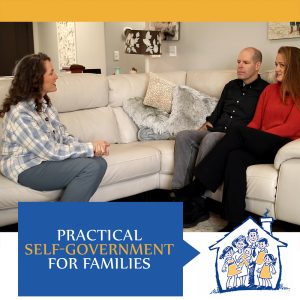“My Mom Doesn’t Have Any Buttons”
by Nicholeen Peck
In 2009 our family was featured on a BBC documentary about parenting and discipline called The World’s Strictest Parents. During the program, the camera crew interviewed my son about what he was witnessing from the troubled teens who came to our home for the filming. My son commented about the unruly behavior he was witnessing, “They’re just trying to push my mom’s buttons. But, what they don’t realize is that she doesn’t have buttons. I know. I’ve tried.”
After the program aired, my social media accounts were inundated with messages from people around the world asking how to not have ‘buttons.’ Parents know that their behavior and emotional responses play a role in the success or failure of their parenting and they don’t want to respond in ways that lead to power struggles and anger, but they don’t know how to get rid of those pesky emotional triggers that we often call ‘buttons.’
“But That Is Blatant Disrespect”
Recently, when witnessing a demonstration of how to be calm, consistent, firm, and focused when a child is being mean or disrespectful and trying to engage in a power struggle, a parent said to me, “I see how calmness can be good, but that is blatant disrespect. I can’t just allow them to be disrespectful. Even if I should, I just can’t.”
This parent saw a conflict between being calm and stopping the rude behavior. She also felt that her triggers were so strong that she was not physically able to stop from blowing up at a person if they were blowing up at her in such a disrespectful way.
This parent is not alone. She was seeing two conflicting principles. What she didn’t see at the time was that those two principles aren’t really in conflict with each other. A parent can have both at the same time if they have a communication plan that promotes calmness and maintains authority and teaching. What’s more, she learned that she can choose to be calm when someone else is being disrespectful if she wants to. It might be hard at first, but she can do it.
What she learned:
- Disrespect is a sign of a power struggle and should be dealt with the same way every time.
- Her mental preparation for future power struggles is key. She needs to have a plan for calmness and consistency. Also, she needs to not take things personally even if the attack sounds personal.
- When someone is saying mean things and being angry they are often in the wrong part of their brain and may not even remember what they said afterwards. It’s just a tantrum.
- You can’t stop a tantrum by having a tantrum yourself.
- Each person in the situation has a role. The parent is the teacher and needs to focus more on teaching lessons than on their own emotions.
- For a lesson to stick it needs to be received with the front brain. Being in the front brain requires the receiver to be calm.
- Fighting back or trying to teach a person about respect when they are angry will only lead to more power struggles.
- Teaching needs to happen about the disrespect when everyone is calm. And, a negative consequence can be earned for going out of control.
- You need to remove your buttons with analysis and your power of choice.
How To Remove Personal ‘Buttons’ And Be Consistent Too
The term ‘button’ means an emotional trigger. Everyone has triggers. Some triggers lead to good habits, and some triggers lead to bad habits. The way we change our habits is to change our triggers or to use our same non-productive triggers in a new way that leads to productive action.
It takes a long time to remove all emotional buttons, especially for more emotionally sensitive people. But, it can be done. I am an emotionally sensitive person, but I not longer focus on triggering negative, non-productive emotions. I’ve switched my triggers.
People who are successful and remove emotional ‘buttons’ and triggers must be deliberate and planned. Changing personal triggers rarely happens by accident. This means that people who have a hard time with follow through may have a more difficult or lengthy time working to adjust triggers.
Here are the five steps that I used to remove my ‘buttons’ when I was a young mother and foster mother.
- Recognize my triggers. I started with one trigger and moved on to addressing more triggers after I was successful with one. My first trigger was an impulse to take other people’s actions and words personally.
- Describe honestly. The truth sets us free. I described what I would feel and think when someone offended me. Then I told myself that I was only looking at this situation from one angle.
- Challenge your thoughts. I asked myself, “What else is true about this situation?” and “Could I be making lies up about this situation because of my own emotional habits?”
- Create a healthy, productive thought that leads to your desired action. These are the thoughts I gave myself for when someone says something that feels hurtful or unkind that I need to not let tear me down. “Give them the benefit of the doubt. Could they have spoken in that way by accident or been thinking that they were sounding different?” And, “I get to choose how I feel about this. I choose to give them the benefit of the doubt and not take that statement personally.”
Obviously, it’s sometimes really healthy to discuss miscommunications so that the person miscommunicating gets an opportunity to improve their speech and relationships. But, personally, I knew that I was interpreting things falsely often enough, that I just needed to take the responsibility for my emotional health and assume the best of others.
- Drop the subject. After thinking a productive thought, just move on. Rumination often harms and rarely solves our problems. I realized that I didn’t have to answer all my questions about every situation that I was in. I could have more power if I choose to be done with the issue and point myself in a forward focus. Momentum really helps to leave things in the past. What do you need to do next? Get moving on something. Old problems, worries, or misconceptions won’t come back when you don’t give yourself time to start rumination. Seeing yourself move on is really liberating.
It’s freeing to have changed so many triggers that my life feels joyful now despite what happens. I’ll forever be grateful that I took the time to replace my negative thought habits and take control of my productivity. I don’t know if my son is right. I don’t know if I don’t have any ‘buttons.’ But, if/when I find a new ‘button’ I know what to do so that it doesn’t take control of me or my relationships.
Watch The World’s Strictest Parents here.
Index
- Addictions, Adults, Analyzing, Attitude, Authority, Balance, Boundaries, Bullying, Calm, Changing Hearts, Character Building, Control, Correcting, Emotions, Entitlement, Family Culture, Hitting, Manipulation, Out of Instructional Control, Power Struggling, Problem Solving, Respect, Roles, Teens (Youth), Toddlers & Younger Children, Tweens, Urgency Addictions






